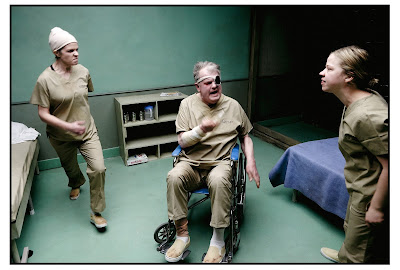James Karas
Factory Theatre wraps up its 2017//18 season with Prairie Nurse by Marie
Beath Badian, a reasonably entertaining sitcom/farce that has a pleasant
romantic story told by stock comedy characters. The three doors for well-timed
entrances and quick exits are there as are the complications of
misunderstanding, the letter getting in the wrong hands and the like. This is a
coproduction by Factory Theatre and Thousand Islands Playhouse and that’s a
clue about the eminent suitability of the play for summer stock.
The play is set Arborfield in the boonies of Saskatchewan, the town that
is a three-hour drive from Saskatoon. Going to Saskatoon for the people of
Arborfield is the equivalent of going to Paris or New York.
There is great excitement in the local hospital because two nurses are
arriving from the Philippines. We meet the exaggerated, goofy, loveable
characters who can walk onto the set of a 1960’s sitcom and fit right in.
Corner Gas, a sitcom based in the Prairies comes to mind and Prairie nurse is
in the same league of comedy.
The two nurses, Penny (Isabel Kanaan) and Puring (Belinda Corpuz) are
attractive and come from different ends of the Filipino social ladder. Penny is
a standoffish snob with pretensions to social standing whereas Puring comes from
a working class background. The really positive aspect of the play is that it
shows Filipino professionals rather than the usual, anecdotally or in reality, importation
of nannies.
Marie (Catherine Fitch), the hospital nurse and “boss” tries to run the
unit which has as many mishaps as Toronto has potholes in the spring. She has
to deal with the Candy Striper Patsy (Janelle Hanna), an over-excited teenage
volunteer who tries to be a matchmaker with (un)expected results.
The lab technician Wilf (Matt Shaw tests men’s samples for pregnancy,
women’s samples for cholesterol instead of pregnancy, drops a tray of samples
on the floor, is accused of having relations with the Filipino nurse and Patsy
while engaged to another woman and is slapped around by Charlie the maintenance
man (Layne Coleman). Is that enough?
Dr. Miles (Mark Crawford) loves hunting, fishing and bear trapping with
a passion and looks and acts like a goof in classic sitcom fashion where
getting a laugh is the only thing that counts.
Charlie the maintenance man (Layne Coleman) is the sole of decency and upholder
of local morality. He does smack around Wilf who is engaged when he romances
another woman. Heavens!
The play is inspired by the author’s mother’s immigration story but is
obviously fictional. Love at first sight (Wilf and Puring), farcical
complications with a happy ending. We are treated to the usual yahoo comments.
The locals can’t tell the two nurses apart and cannot remember their names but
all of the characters are essentially decent and the mayhem caused by bobbling
and misunderstandings are the classic fodder of comedy.
Director Sue Miner did not skimp on any of the comic business of a
sitcom or farce and she produced a good deal of laughter. The cast does its
best with the material and leaves us reasonably entertained.
_____
Prairie Nurse by Marie Beath Badian in a Factory Theatre
and Thousand Islands Playhouse coproduction opened on April 26 and will run until
May 13, 2018 at the Factory
Theatre, 125 Bathurst Street, Toronto, Ontario. www.factorytheatre.ca/













